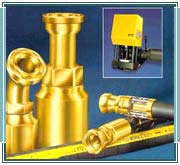Complete Powerpoint slide presentation for forklift instructors. Ready made training course
Fork lift truck hydraulic systems - Hydraulic hoses
 Modern day fork lifts have very sophisticated hydraulic systems which are often controlled electronically in the same way as traction systems. Lets start by looking at some of the components that go to make up a hydraulic system.
Modern day fork lifts have very sophisticated hydraulic systems which are often controlled electronically in the same way as traction systems. Lets start by looking at some of the components that go to make up a hydraulic system.
Hydraulic systems - hoses
A hydraulic hose consists of an inner tube through which the fluid is conveyed and comes into direct contact with the hydraulic fluid. The rubber or other synthetic material used for this needs to be compatible and able to withstand the range of working temperature without losing its chemical and physical stability.
The hydraulic hoses can be made using a variety of materials, depending on the factors of oil compatibility, abrasion resistance etc. A variety of hose types and connections are used in lift truck design.
Important Points
The hydraulic hoses need frequent maintenance that facilitates smooth working thereby increasing their service life. Some important considerations are:
-
The excessive tension in the connected hose should be avoided while connecting two elements through a hose.
-
When pressure is applied to hose, the hose tends to bulge and decrease in length. Thus slackness needs to be permitted to avoid strain to the hose.
-
They should not be installed with a twisting as it may weaken the hose structurally and cause loosening of the fittings.
-
High temperature may damage the hose cover and may shorten its useful life. Hence under hot working conditions, the hoses should be protected through proper heat insulation by using heat resistant hose material.
-
The hose run should be such that rubbing and abrasion with the metal members of the system are avoided. Clamps and hose guards are often used to group the hoses and keep them away from the moving parts.
-
The hose manufacturer's guidance and specific instructions need to be taken care of with regard to bend radius, environment and oil' compatibility, pressure capability, etc.